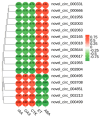Identification and Characterisation of the CircRNAs Involved in the Regulation of Leaf Colour in Quercus mongolica
- PMID: 38534452
- PMCID: PMC10968399
- DOI: 10.3390/biology13030183
Identification and Characterisation of the CircRNAs Involved in the Regulation of Leaf Colour in Quercus mongolica
Abstract
Circular RNAs (circRNAs) are important regulatory molecules involved in various biological processes. However, the potential function of circRNAs in the turning red process of Quercus mongolica leaves is unclear. This study used RNA-seq data to identify 6228 circRNAs in leaf samples from four different developmental stages and showed that 88 circRNAs were differentially expressed. A correlation analysis was performed between anthocyanins and the circRNAs. A total of 16 circRNAs that may be involved in regulating the colour of Mongolian oak leaves were identified. CircRNAs may affect the colour of Q. mongolica leaves by regulating auxin, cytokinin, gibberellin, ethylene, and abscisic acid. This study revealed the potential role of circRNAs in the colour change of Q. mongolica leaves.
Keywords: Quercus mongolica; anthocyanin; circRNA; hormones; leaf colour.
Conflict of interest statement
The authors declare no conflict of interest.
Figures





References
-
- Li Z. Ph.D. Thesis. Inner MongoliaAgricultural University; Hohhot, China: 2015. Study on Drought Resistance and Ornamental Value of Betula Platyphylla and Quercus mongolica at Hohhot.
Grants and funding
LinkOut - more resources
Full Text Sources

